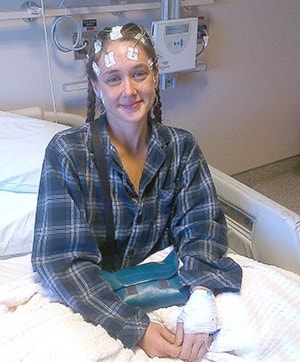One of the many frustrations
of my disease is the
general lack of knowledge
of epilepsy and although
it is complicated, knowing
what a person with epilepsy
is experiencing can take
away much of the stigma
and fear.
The following is a brief
outline of one of the most
common types, known as a
‘simple partial seizure’ and
what the patient could be
experiencing.
Simple partial seizures,
also known as focal seizures,
occur in one area of
the brain (commonly the
hippocampus, main area
of memory, learning, and
emotion), lasting between
10 to 40 seconds with consciousness
fully intact.
Of the more than 40 seizure
types they play a big
part in the cause of stigma,
as physical movements, reaction
to odd sensations
and slurred speech can
seem one is intoxicated,
on drugs, or ‘out of it’.
Simple partials are medically
categorized into four
groups:
• Motor seizures: These
cause a change in muscle
activity. A person may have
abnormal movements such
as jerking of a finger or
stiffening of part of the
body. These movements
may stay on one side of
the body (opposite the affected
area of the brain) or
extend to both sides. They
may cause weakness, which
can affect speech and coordinated
actions such as
hand movements; blinking;
or twitching of the face.
• Sensory seizures: These
cause changes in any one
of the senses. People with
sensory seizures may smell
or taste things that aren’t
there; hear clicking, ringing,
or a voice when there
is no sound; feel a sensation
of ‘pins and needles’;
or like they are floating.
They may have visual hallucinations
of things that
aren’t there (ie: a scene with
people), or experience distortions
of true sensations
(ie: a parked car is moving
away, or a person’s voice is
muffled when it’s actually
clear).
• Autonomic seizures:
These cause changes in the
part of the nervous system
that automatically controls
bodily functions.
This may include strange
or unpleasant sensations in
the chest, head, or stomach
(known as epigastric
rising); changes in heart
rate or breathing; sweating
or flushing (face and/
or neck turns red and hot);
or goose bumps.
• Psychic seizures: These
seizures change how people
think, feel, or experience
things. They may have
problems with memory,
speech, or understanding
spoken or written language.
They may feel emotions
like fear, depression,
or happiness with no outside
reason. It is common
to have feelings of déja
vu (“I’ve been through
this before”) or jamais vu
(“This is new to me”, even
though the setting is really
familiar). If the area of the
brain involved with memory
is affected, there may
be internal visual images
of people and places from
the past.
The majority of patients
with simple partials experience
at least two of the
four types, and in the same
order.
Doctors call this type of
seizure behaviour ‘stereotyped.’
Learning the order,
timing, and likelihood of
further seizure activity is
paramount to knowing
your epilepsy and the best
measures to follow.
Prior to brain surgery I
experienced thousands of
simple partials.
They began with an internal
image of a woman’s
face on a black background
(“I‘ve seen her before, I
know her”, though she
was a total stranger and
post-seizure I couldn’t describe
her), followed by
epigastric rising, flushing
and intense fear.
Though consciously stopping
any seizure is not possible,
that is often irrelevant
to the patient.
Like a subconscious distraction,
my attempt to
re-focus neuronal activity
was rubbing fingers against
thumbs similar to repetitive
squeezing.
If activity reached one
minute without peaking, I
lost ability to control motion
and it evolved into a
tonic clonic (grand mal)
seizure.
In 2013, the last tonic
clonic seizure began in my
sauna.
I got out before losing
consciousness (when a
simple partial evolves it is
referred to as an ‘aura’ - a
warning), though my face
was injured due to repetitive
strikes against the bottom
of the glass door.
Four weeks later surgery
took place at Vancouver
General Hospital (VGH),
and part of my left temporal
lobe was removed.
It was a success, one that
wouldn’t have been possible
without the VGH Seizure
Investigation Unit (SIU).
Of the 32,000 adults with
epilepsy in BC, more than
7,000 are possible surgery
candidates, yet the SIU has
only two beds.
From clinic consult to SIU
my wait was 14 months and
during that time I had more
than 100 seizures.
It has been 38 years since
the SIU was implemented
in 1979 and though epilepsy
diagnosis is steadily on
the rise there are still only
two beds, making B.C. one
of the most underfunded
provinces in researching and
fighting this life-threatening
disease.
2017 marks year four of
epilepsy Quesnel’s (eQ) endeavour
to help the VGH
Epilepsy Clinic raise funds
for beds 3 and 4, please join
us!
Purple Day in Quesnel is
Friday, March 24 at various
locations.
See full list of participating
businesses on the
big purple posters with
events leading up to Global
Purple Day for Epilepsy
March 26, including a
night with Latin superstar
Alex Cuba at The Occidental,
March 2
